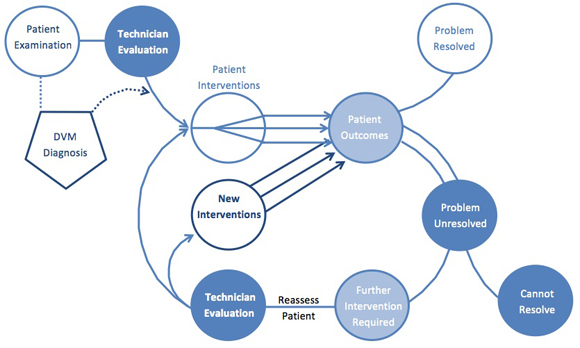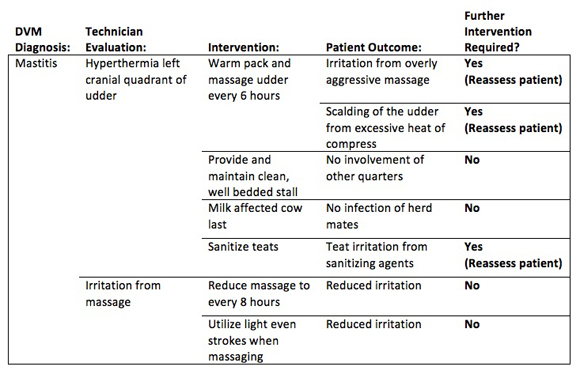Continued Patient Reassessment

Welcome to the Purdue OWL
This page is brought to you by the OWL at Purdue University. When printing this page, you must include the entire legal notice.
Copyright ©1995-2018 by The Writing Lab & The OWL at Purdue and Purdue University. All rights reserved. This material may not be published, reproduced, broadcast, rewritten, or redistributed without permission. Use of this site constitutes acceptance of our terms and conditions of fair use.
Objective
- To continually reassess and revise a patient's condition and the accompanying documentation.
What to Do
Patient care over a period of time is a continual process that is not static or linear. The patient's needs fluctuate and treatment plans evolve as the patient responds to treatment. This fluctuation obliges the veterinary technician to constantly reassess the patient, amend technician evaluations as needed, and record all changes in the medical record as they occur. The flow chart below illustrates this process (image created by Margaret Lump, BS, RVT).

After all data has been collected and recorded from the veterinary techician's (VT) examination of the patient, the DVM’s examination, laboratory results, medical records, and the observations of the owner, the VT identifies the patient’s needs and determine the appropriate interventions. While a diagnosis can only be made by the DVM—who is trained and licensed to determine the cause of a particular set of signs—the VT can make judgments about the patient’s response to these signs. The VT should also anticipate possible complications and/or future conditions and identify proper interventions accordingly. In emergency situations, the VT may be required to plan and carry out interventions immediately and without a written care plan, but in all other cases, it is important that the VT document each of the five sections below in order to provide optimum care.
- Make a list of the patient’s technician evaluations, ordered from the highest to lowest priority.
- Draw up a list of nursing (VT) and medical (DVM) interventions corresponding to the patient’s problems and needs. Identify each intervention as either nursing (VT) or medical (DVM).
- Provide the rationale for each intervention (in an academic environment, it may be necessary to include references to relevant sources).
- Draw up a list of the desired resolutions that could arise as a result of the interventions. Also identify the steps to treat and mitigate the effects of potential problems.
- Develop patient discharge plans, giving specific criteria of what observable signs would indicate the patient’s progress and/or full recovery. Note the negative responses that would be cause for alerting the DVM/VMD.
Example
The following example outlines continued assessment of the mastitis cow care plan mentioned above.
